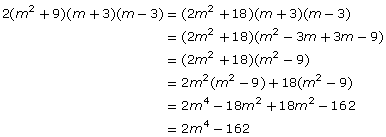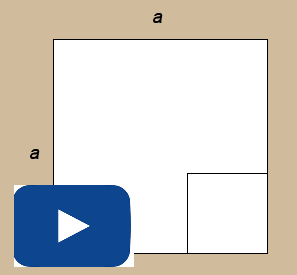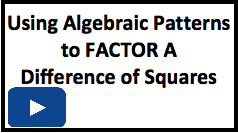Lesson 5: Factoring Special Polynomials
Module 3: Polynomials
Explore
Glossary Terms
Add these terms to your "Glossary Terms' in your notes:
-
conjugate binomials
-
difference of squares
-
perfect square trinomial

© Dimanchik/shutterstock
--------------------------------------------------------------------
Factoring a Difference of Squares
A special case of a trinomial is known as a difference of squares. You will recognize a polynomial as a difference of squares when you observe that the polynomial
-
is a binomial
-
has a first term that is a perfect square
-
has a second term that is a perfect square
-
shows the subtraction of one term from another
As an example, x2 – 4 is considered a difference of squares since both x2 and 4 are perfect squares and one is being subtracted from the other. Although x2 – 4 is expressed as a binomial, it can be viewed as a trinomial whose x-term has a coefficient of zero. In other words,
x2 – 4 = x2 + 0x – 4
When viewed this way, a difference of squares can be factored by using trinomial factoring methods. In this case, you can use the product-sum method.
Example 1
Factor x2 – 4.
Solution
Think about the difference of squares as the trinomial x2 + 0x – 4.
Step 1: Find two numbers whose product equals –4 and whose sum equals 0.
|
First Number |
Second Number |
Product |
Sum |
|
1 |
–4 |
–4 |
–3 |
|
2 |
–2 |
–4 |
0 |
Choose the combination that gives the correct sum. (See the numbers shown in the second row of the chart.)
Step 2: Express the polynomial as a product of its factors.
x2 – 4 = (x + 2)(x – 2)
Do you notice that the two factors are almost identical except for the sign of the constant? These factors are known as conjugate binomials.
 Tip
Tip
Conjugate Binomials: Binomials with the same terms but different sign between the terms.
ie: ( x + 2) and ( x - 2) are conjugate binomials
( 3x - 2) and ( 3x + 2) are conjugate binomials
There is another method of factoring a difference of squares. In the Discover section you used graph paper to visualize a difference of squares by removing a square with smaller dimensions from one with larger dimensions.
Retrieve and review your Math Lab results. Compare the last three columns of your completed table to the one below.
|
Dimensions of Original Square |
Dimensions of Removed Square |
Rectangle Length |
Rectangle Width |
Rectangle Area |
|
10 × 10 |
6 × 6 |
10 + 6 |
10 – 6 |
(10 + 6)(10 – 6) |
|
8 × 8 |
3 × 3 |
8 + 3 |
8 – 3 |
(8 + 3)(8 – 3) |
|
7 × 7 |
4 × 4 |
7 + 4 |
7 – 4 |
(7 + 4)(7 – 4) |
|
5 × 5 |
2 × 2 |
5 + 2 |
5 – 2 |
(5 + 2)(5 – 2) |
Can you see how the area of the rectangle can be determined by knowing only the dimensions of the original square and the removed square?
 Watch and Listen
Watch and Listen
Watch the video titled “Difference of Squares” to see how this pattern can be generalized for any square.
Example 2
Factor 9x2 – 4y2 completely and check by multiplying.
Solution
Step 1: Determine the square roots of 9x2 and 4y2.
![]()
![]()
Step 2: Write one factor as the sum of the square roots. Write the other factors as the difference of the square roots.
9x2 – 4y2 = (3x + 2y)(3x – 2y)
Step 3: Check by multiplying.

The original difference of squares is recovered, so the factors are correct.
Example 3
Factor 2m4 – 162 completely and check by multiplying.
Solution
Step 1: Check for common factors.
![]()
The greatest common factor is 2.
Therefore, 2m4 – 162 = 2(m4 – 81).
Step 2: See if you can continue to factor the binomial.
You can continue to factor m4 – 81 as a difference of squares.
Determine the square roots of each term in the difference of squares.
![]()
![]()
Therefore, 2(m4 – 81) = 2(m2 + 9)(m2 – 9).
Step 3: See if you can continue to factor the binomials.
You can continue to factor the binomial m2 – 9 as a difference of squares.
m2 = m × m
9 = 3 × 3
So, 2(m2 + 9)(m2 – 9) = 2(m2 + 9)(m + 3)(m – 3).
 Tip
Tip
Remember that you can only factor a difference of squares, not a sum of squares.
So, m2 – 9 = (m – 3)(m + 3), but m2 + 9 cannot be factored.
Step 4: Check by multiplying.

The original difference of squares is recovered, so the factors are correct.
 Watch and Listen
Watch and Listen
You have just learned two ways to approach the factoring of a difference of squares. If you feel that you would benefit from another explanation, go to the YouTube website “Mathcast 014 Using Algebraic Patterning to Factor a Difference of Squares” video.
 Read
Read
In your textbook, there are some additional examples of factoring a difference of squares using the ideas developed in this lesson. As you read, check that the polynomials meet the conditions for factoring as a difference of squares.
Foundations and Pre-calculus Mathematics 10 (Pearson)
Read “Example 3: Factoring a Difference of Squares” on page 193. How do you factor a difference of squares if the coefficients of the binomial are not perfect squares? How do you deal with terms with two variables?
 Self-Check
Self-Check
SC 1. For each of the following questions, decide if the expression can be factored as a difference of squares. If so, factor the expression completely. If not, explain why it cannot be factored.
- x2 + 4
- –9x2 + 36y2
- –x2 – 49
- 81x2 – 144y2
 Try This 1
Try This 1
Apply the method of factoring a difference of squares to these questions from your textbook. Remember that certain conditions have to be met before this technique can be used to factor a polynomial. You may want to review these conditions before you attempt these questions.
Complete the following in your course folder ( binder).
Foundations and Pre-calculus Mathematics 10 (Pearson)
TT 1. Complete “Exercises” questions 6.b), 6.d), 10.a), 10.c), 10.e), 10.g), and 21 on pages 194 and 195.
Use the link below to check your answers to Try This 1.
Possible TT1 (Try This 1) Solutions

